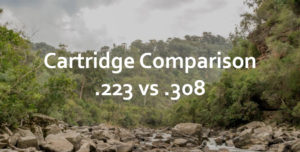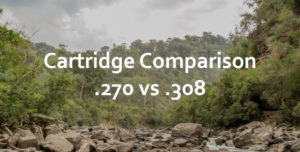Comparing the .243 Winchester vs .308 Winchester
There are not so many fertile calibres such as .30-06 Springfield that have spawned and inspired the creation of so many successful cartridges directly or indirectly.
Most of the .30-06’s descendants have the overall versatility their parent possesses, but a couple of them stand out from the crowd. Since its debut in 1906, the wildcatters and gun designers started modifying the .30-06 Springfield to develop new and more specialized cartridges to respond to the challenges of the modern age.
If we consider the .308 Winchester as the first generation in the evolution of .30-06, then the .243 Winchester is the second generation in further modification and development of venerable 06.
However, even though they are similar in many ways, there are some different specs between the .243 and .308 cartridges that you should be aware of.
| .243 Winchester | .308 Winchester | |
| Bullet Diameter | .243 in (6.2 mm) | .308” (7.8 mm) |
| Case Length | 2.045 in (51.9 mm) | 2.035” (51.7 mm) |
| Overall Length | 2.71 in (68.83 mm) | 2.80” (71.1 mm) |
| Rim Diameter | .473” (12.0 mm) | .473” (12.0 mm) |
| Case Capacity | 53.7gr H2O (3,48g) | 56 gr H2O (3.62 g) |
| Max Pressure (SAAMI) | 60,000 psi (410 MPa) | 62,000 psi (430 MPa) |
| Muzzle Velocity | 2,960 fps (910 m/s) | 2,820 fps (860 m/s) |
| Muzzle Energy | 1,945 ft-lbs (2,637 J) | 2,648 ft-lb (3,590 J) |
| Bullet | 100 gr (6.0 g) | 150 gr (9.72 g) |
| Powder Load | 45.2 gr (2.93 g) | 46.3gr (3.0 g) |
| Rifle Weight | 7.5 lb. (3.4 kg) | 7,5 lb. (3,4 kg) |
| Free Recoil Energy | 8.8 ft-lbs (11.9 J) | 18,27 ft-lbs (27,7 J) |
.308 Winchester
Similar to the original .30-06 Springfield, the new .308 Winchester was developed with a service rifle in mind. What’s more, the post-war military mindset did not change in terms of long-range fire, so they were looking for the primary rifle cartridge that will inherit and achieve the same level of performance with a shorter case length (2.035″ vs 2.49″).
The development that followed resulted in a successful prototype called Ball, Cal. 30 T65 based on the .300 Savage. Soon, Winchester standardises T-65 commercially and released it in 1952, as a new sporting cartridge, the .308 Winchester.
After some trials and refinements in 1953, a T-65E3 improved version was accepted as the NATO cartridge and re-named the 7.62 NATO.
The rimless, bottleneck .308 Winchester cartridge was first chambered in Winchester bolt action Model 70, lever-action Model 88, and semi-automatic Model 100 rifles. Contrary to popular belief, .308 wasn’t an instant success among sportsmen as they were hesitant at first in accepting this new unproven hunting cartridge. Only after .308 emerged from the shadow of his .30 cal big brother did, the shooting public have a chance to notice the versatility the shorter chambering was offering and latched on to it.
Beyond the obviously lighter recoil, the .308 Winchester was offered in more handy rifles due to the short action design. While the .308Win delivers about 100 fps (30m/s) less muzzle velocity than the larger .30-06, it has excellent terminal ballistics to produce clean kills on the medium game out to ranges of 600 yards.
Simultaneously with military 7.62x51mm NATO ammunition, the sporting .308 cartridge was quickly adopted by every major firearms company. While these two cartridges are not identical regarding the thickness of brass, they have the same sized outside dimensions and can be used either in military or sporting rifles with a certain measure of caution.
The original .308 Winchester loaded with 150 grain bullet achieved 2,700 feet per second, virtually the same ballistics as the aging .30-06 Springfield due to advances in powder technology.
Since it duplicated the performance of the .30-06, but with lesser recoil, it quickly became a highly popular medium game cartridge with many American hunters and shooters.
There is a good selection of available ammunition for the .308 Winchester ranging from 100 grains to 208 grains depending on the bullet manufacturer.
Classified as universal intermediate calibre, .308 can use bullets from 110 grains up to 140 grains for smaller game and small to medium-sized predators. Using heavier projectiles like 165, 180, and 200-grain bullets, the .308 is suitable for most North American big game, including deer, wild boar, black bear, and caribou.
Being noted for exceptional accuracy, this warrior at birth is a renowned medium game cartridge that hits way above its weight class.
Using the larger 7.62mm projectile than the 6mm found in the .243 Winchester, the .308Win is great for home defense. The heavier, larger .308 projectiles generate more energy, but a 100-grain heavy .243 projectile behaves predictably in the wind resulting in less hold over and easier shots out to various ranges.
Although there are many new intermediate cartridges of advanced construction making .308 Win inferior to these cartridge designs, it is still the most popular short-action hunting cartridge in the United States.
.243 Winchester
The .308 Winchester is the parent case for a number of wildcat cartridges becoming very popular for hunting, particularly in North America. While many of the .308’s descendants are quite good, only one in our humble opinion has the overall versatility its parent possesses. We are talking about a .243 Winchester or 6.2x52mm.
The .243 Winchester is a modification of the .308 Winchester case necked down to .243″ (6mm).
Designed in the early fifties as a wildcat, the .243 Winchester caught on with a hunting population mostly thanks to famous gun writer Warren Page, the editor of Field & Stream. He extolled the virtues of the .243 in his columns, convincing readers that 6mm bullets were far superior to boring old .25-calibre projectiles.
The idea was to use different loads in one round to make a versatile cartridge for hunters wanting a true dual-purpose rifle. That said, the .243 is perfect in a light deer rifle, but it still offers the advantages of the high-velocity .22-calibres for varmint/ pest hunting.
The .243 Winchester is one of the most popular examples of cartridge developed by necking down the .308 Winchester to shoot smaller diameter bullets. For this excellent cartridge, Winchester purpose-built their new Model 70 Featherweight, a lighter version of the Rifleman’s Rifle, the Model 70. Needless to say, the .243 Win. the Model 70 combo was able to deliver the precise shot placement varmint hunters need.
The .243 Winchester is purely a hunting rimless, bottleneck cartridge with no military background, unlike the .308 Winchester. Since the .308 Winchester is the parent case for the .243, both cartridges have the same case capacity and same rim of .473″ diameter. The .308 and .243 also have very similar maximum SAAMI pressures of 62,000 psi (427 MPa) and 60,000 psi (410 MPa), respectively.
The .243 bullets generally range from 55 grain to 115 grain depending on what you want the cartridge to do. You can load down with a 55 grain bullet and have a great small varmint/pest load, load up to an 80 grain bullet for coyote, bobcat, and fox, and loads with heavier 90 and 100-grain bullets will be a lethal set up for deer and pronghorn antelope.
Since the .243 Win is a very popular hunting cartridge for hunting deer-sized game, its typical 1:10″ rifling twist could reliably stabilize bullets over about 90 grains which the hunting community wanted for deer and similar species.
Compared to .308 at longer ranges, the flat shooting .243 is a good varmint cartridge but it’s not recommended for a medium-sized game. Certainly, the .243 is good all-around rifle chambering, but it lacks the energy to take a bigger game down at 200 yards humanely and swiftly.
Besides flatter shooting and minimal drop, the main selling point is substantially less recoil .243 generates in comparison to a .308 Winchester. It is about half the recoil of a .308 Winchester. It means the .243 Winchester does offer faster follow-up shots and makes an ideal choice for female or smaller stature shooters.
The .243 Winchester is very practical for those people who want only one rifle for anything from small varmint and pests up to deer-size animals. Additionally, the .243 Winchester is a very good choice for hunters living in countries that restrict or forbid private ownership of firearms chambered in military calibers like .223, .308 and similar.
Related: Read our guide on comparing the differences between the .270 and .308w
Final thoughts on the .243 vs. .308w
After some comparisons in a previous part, most of you would find that the .243 Winchester and .308 Winchester have so much and yet so little in common.
On the one hand, both rounds have the same case size and case capacity, but on the other hand, they are designed for different tasks. While the sporting .243 Winchester is mostly found in bolt action rifles, the .308 can be chambered in nearly any action type of rifle.
As for the affordability and commonness, the .243 Winchester has always been a hunting round with usually premium-grade hunting loads, whereas the .308 and particularly its military variant 7.62 NATO are substantially cheaper and available in a much broader array.








